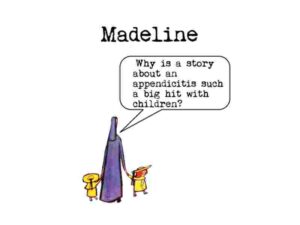Madeline
Why is a story about an appendicitis such a big hit with children?

Madeline- Why is a children’s story about an appendicitis such a big hit?
At first glance it’s rather bewildering that a tale about a small girl at boarding school who suffers from an appendicitis is an enduring classic that’s been read to generations of children. After all, how many young kids long for stories of medical emergencies?
It hardly seems like a promising basis for a children’s book to rely on, but careful analysis reveals that Madeline is actually a mastercraft of storytelling that created an ideal world for children to engage with.
Ludwig Bemelmans, the author of Madeline, had a less than ideal childhood. When he was six his father abandoned his family, leaving behind both his wife and Bemelmans’ governess pregnant with his children. The governess committed suicide in the aftermath and his mother uprooted, leaving France for Germany and taking the young Bemelmans with her.
For Bemelmans, writing children’s books was a way to deal with the trauma of his own upbringing.
“I have forgotten so much of youth, and much of it was not experienced,” he once wrote to a friend. “In me a whole portion of it is missing – it is like a floor in a house where there is no furniture.” And, in another letter: “In the middle of the night, I often wake up – and stare at the open doors through which I cannot walk and at the closed ones that I can’t open – and the children’s books that keep me from blowing out my brains are created in this hour.”
With Madeline, Bemelmans recreated what his childhood should have been, a world with stability and where the adults are reliable.
The book starts with the famous words “In an old house in Paris that was covered with vines lived twelve little girls in two straight lines.”
Madeline, like many great books, establishes setting right away. The book takes place in a specific city, Paris, and a specific old house “which is covered in vines.”
Then the book tells about the reliable schedule that the little girls keep day in and day out.
“In two straight lines they broke their bread and brushed their teeth and went to bed.”
These lines capture the interest of kids because very young children have an innate desire for an environmental order which is deeply psychologically ingrained. Maria Montessori, an Italian physician who developed a whole theory of education to harness the desire of children, wrote “I have observed over and over again that children have a feeling for orderliness. Your child will learn to know where he may find things and he will put them back of his own accord when he has finished with them. ”
After establishing the atmosphere, Bemelmans establishes the character of Madeline.
He gives Madeline two defining character traits: she’s small and she’s brave. Since Madeline is small, that means she’s cute and engages the readers’ sympathy.Her bravery makes her virtuous and a person to be admired.
Then into the tranquility of this ideal situation a problem arises: Madeline faces a dangerous medical problem.
Yet even though Madeline is in an exciting situation, the adults around her all behave in a competent manner.
Miss Clavel responds to Madeline’s distress with almost magical abilities, the doctor makes sure she receives the correct medical attention and her father lavishes her with gifts.
When the other little girls visit, they grow jealous of the toys, attention, and the scar that Madeline received.
But Miss Clavel also takes care of the emotional needs of her children. When again with her magical powers she senses a disturbance in the middle of the night, Miss. Clavel rushes to the little girls and discovers that envy has taken over their hearts.
She responds with sound wisdom to their foolish desire to “have our appendix out, too!”
“’Good night, little girls. I Thank the Lord you are well! And now go to sleep!’ said Miss Clavel.”
Miss Clavel comforts the little girls by pointing out the great value of the comfortable, if uneventful, life that they enjoy.
While the book of Madeline has good themes for children, it also has important themes that adults can learn from.
Children could use adults like Miss Clavel in their lives.
- She creates order.
- She responds correctly to Madeline’s physical emergency.
- She kindly deals with an emotional crisis that doesn’t make sense from an adult’s point of view.
While at first glance the story of Madeline might seem like an unlikely tale, a closer examination reveals that it delivers the security and adventure that children long for. Bemelmans never got to experience the childhood of Madeline as the adults if his life were too caught up in their life problems or selfish chaos to take care of him.
So he created a story that incorporated all the elements of childhood that he was missing and while children love the story of Madeline because it gives them a sense of security, it also provides a guide to how adults can build an environment that will meet the emotional needs of children.
